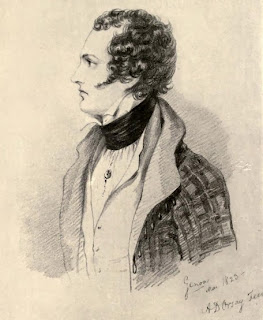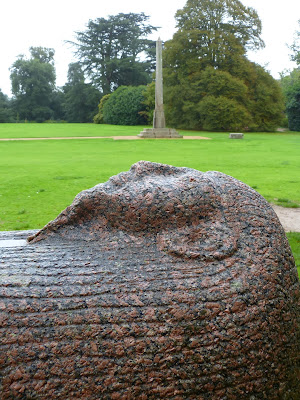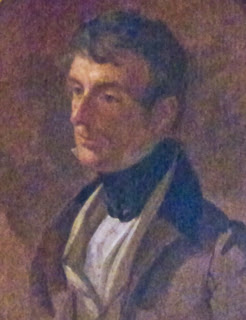William Bankes (11 December 1786 - 15 April 1855) was an antiquarian and Egyptologist and the owner of the Kingston Lacy and Corfe Castle estates in Dorset.
Family
William John Bankes was born on 11 December 1786, the son of Henry Bankes, a wealthy Dorset landowner and politician, and Frances Woodley, a celebrated beauty, who was the daughter of the governor of the Leeward Islands. The Bankes estates included the family seat of Kingston Lacy, Corfe Castle, Studland and the Purbeck hills.
Education
William was educated at Westminster School and went up to Trinity College, Cambridge, in June 1803, where he became close friends with Lord Byron and gained a reputation for extravagance and wild living. Byron described William as his “collegiate pastor, and master, and patron” and “good-naturedly tolerant of my ferocities”. He declared that William “ruled the roast – or rather the roasting – and was father of all mischiefs.”1
Family
William John Bankes was born on 11 December 1786, the son of Henry Bankes, a wealthy Dorset landowner and politician, and Frances Woodley, a celebrated beauty, who was the daughter of the governor of the Leeward Islands. The Bankes estates included the family seat of Kingston Lacy, Corfe Castle, Studland and the Purbeck hills.
Education
William was educated at Westminster School and went up to Trinity College, Cambridge, in June 1803, where he became close friends with Lord Byron and gained a reputation for extravagance and wild living. Byron described William as his “collegiate pastor, and master, and patron” and “good-naturedly tolerant of my ferocities”. He declared that William “ruled the roast – or rather the roasting – and was father of all mischiefs.”1
Through the patronage of Lord Falmouth, who married his sister Ann, William became MP for Truro in 1810. He generally supported the government, but failed to shine in political circles and the speeches he made in parliament were unimpressive. He gave up his seat at the dissolution of 1812.
He later became Tory MP for the University of Cambridge (1822-6), Marlborough (1829-32), and then Dorset (1832-4).
He later became Tory MP for the University of Cambridge (1822-6), Marlborough (1829-32), and then Dorset (1832-4).
Byron’s fashionable friend
Although only the second son, William became heir to his father in 1806 on the death of his elder brother, Henry, and was given an income of £8,000 a year. In 1815, he inherited Soughton Hall in Flintshire from his great grandfather.
During the season of 1812, William and Byron were central figures in society. Byron referred to William as one of his
During the season of 1812, William and Byron were central figures in society. Byron referred to William as one of his
...early friends. He is very clever, very original and has a fund of information: he is also very good-natured; but he is not much of a flatterer.2
 |
| Lord Byron from A Journal of the Conversations of Lord Byron with the Countess of Blessington (1893) |
William proposed to the bluestocking heiress Annabella Milbanke, but was refused. She later married Byron.
After his rejection, William followed in Byron’s footsteps and set out on his own Grand Tour. He followed Wellington’s army through Spain and Portugal, purchasing paintings during the disruption of the Peninsula War.
Over the next eight years, William travelled extensively in Italy, Syria and Egypt. He stayed on Mount Lebanon, crossed the desert to Palmyra, travelled up the Nile, explored to the east of the Dead Sea and became one of the first Europeans to reach Petra. Byron nicknamed him the Nubian Explorer or Discoverer.
He employed an Italian, Giovanni Finati, as his interpreter and guide. Later on, he was accompanied by another Italian, the archaeologist, Giovanni Belzoni.
Over the next eight years, William travelled extensively in Italy, Syria and Egypt. He stayed on Mount Lebanon, crossed the desert to Palmyra, travelled up the Nile, explored to the east of the Dead Sea and became one of the first Europeans to reach Petra. Byron nicknamed him the Nubian Explorer or Discoverer.
He employed an Italian, Giovanni Finati, as his interpreter and guide. Later on, he was accompanied by another Italian, the archaeologist, Giovanni Belzoni.
William the archaeologist
The importance of William’s archaeological work has tended to be undervalued because he published very little apart from Finati’s memoirs. He and his team made detailed plans of various sites including the temple at Luxor which are a very important source for Egyptologists as they are not merely artistic impressions, but accurate records accompanied by careful transcriptions.
 |
| From William Bankes' Egyptian collections at Kingston Lacy (2013) |
William visited the temple of Rameses II and copied all the wall paintings by candlelight and recorded many objects which have since been lost or destroyed. He carried out excavations at El-Sebua in Nubia and at Abydos, where he found the table of the kings, which is now in the British Museum.
The Philae obelisk
William amassed a collection of Egyptian artefacts many of which are on display in the billiards room at Kingston Lacy. But his most impressive artefact is the Philae obelisk which has sat in the garden at Kingston Lacy since 1839. William employed Belzoni to bring the obelisk to England and it took him twenty years to do it! On the first attempt to move it, it ended up on the river bed. William produced lithographs of the bilingual inscriptions on the obelisk which were a valuable aid to understanding hieroglyphics.
The Philae obelisk
William amassed a collection of Egyptian artefacts many of which are on display in the billiards room at Kingston Lacy. But his most impressive artefact is the Philae obelisk which has sat in the garden at Kingston Lacy since 1839. William employed Belzoni to bring the obelisk to England and it took him twenty years to do it! On the first attempt to move it, it ended up on the river bed. William produced lithographs of the bilingual inscriptions on the obelisk which were a valuable aid to understanding hieroglyphics.
 |
| An Egyptian sarcophagus and the Philae obelisk in the gardens of Kingston Lacy (2013) |
When he returned to England in 1820, William rebuilt Soughton Hall according to his own design, aided by the architect Charles Barry, whom he had met on his travels. Barry later designed the new building for the Travellers Club to which William belonged and the Houses of Parliament.
As soon as he inherited Kingston Hall in 1834, William started to remodel it with Barry’s help. He moved the entrance back to the north front and dug down to create a new basement entrance where visitors could alight from their carriages out of the rain. He created a Loggia and put in a marble staircase.3 He created a new, bigger dining room and the Spanish Room in which to display his Spanish paintings.
As soon as he inherited Kingston Hall in 1834, William started to remodel it with Barry’s help. He moved the entrance back to the north front and dug down to create a new basement entrance where visitors could alight from their carriages out of the rain. He created a Loggia and put in a marble staircase.3 He created a new, bigger dining room and the Spanish Room in which to display his Spanish paintings.
William’s personal life was beset with scandal. In 1820, he was forced to pay damages to James Silk Buckingham for libel after accusing him of stealing and publishing his research.
Then, in 1823, he was subject to a suit for criminal conversation, that is, adultery, with Anne Hobart, Lady Buckinghamshire.
But by far the most serious scandal revolved around repeated accusations of homosexuality, which was at that time a capital offence. In 1833, he was found not guilty after character references from, among others, the Duke of Wellington, but when further allegations were made in 1841, William fled the country.
Exile and death
William lived in Venice for the rest of his life, leaving his estates in the hands of his brother George. But he continued to transform Kingston Lacy from a distance under the supervision of his widowed sister, Lady Falmouth.
He commissioned Carlo Marochetti to create bronze sculptures of Chief Justice Bankes, Dame Mary and Charles I for the Loggia.
Then, in 1823, he was subject to a suit for criminal conversation, that is, adultery, with Anne Hobart, Lady Buckinghamshire.
But by far the most serious scandal revolved around repeated accusations of homosexuality, which was at that time a capital offence. In 1833, he was found not guilty after character references from, among others, the Duke of Wellington, but when further allegations were made in 1841, William fled the country.
Exile and death
William lived in Venice for the rest of his life, leaving his estates in the hands of his brother George. But he continued to transform Kingston Lacy from a distance under the supervision of his widowed sister, Lady Falmouth.
He commissioned Carlo Marochetti to create bronze sculptures of Chief Justice Bankes, Dame Mary and Charles I for the Loggia.
 |
| The sculptures of Dame Mary Bankes and Charles I in the Loggia at Kingston Lacy (2013) |
William died in Venice on 15 April 1855 and was buried in the family vault at Wimborne Minster, Dorset.
Rachel Knowles writes clean/Christian Regency era romance and historical non-fiction. She has been sharing her research on this blog since 2011. Rachel lives in the beautiful Georgian seaside town of Weymouth, Dorset, on the south coast of England, with her husband, Andrew.
Find out more about Rachel's books and sign up for her newsletter here.If you have enjoyed this blog and want to encourage me and help me to keep making my research freely available, please buy me a virtual cup of coffee by clicking the button below.
Notes
(1) From a letter written by Lord Byron to John Murray, 19 October 1820 from Byron’s Letters and Journals, ed Leslie A Marchand (1976)
(2) From A Journal of the Conversations of Lord Byron with the Countess of Blessington (1893)
(3) A loggia is a roofed gallery, often on a upper storey overlooking a courtyard, which is open to the air on at least one side.
Sources used include:
Baigent, Elizabeth, Bankes, William John (1786-1855) Oxford Dictionary of National Biography (Oxford University Press, 2004; online edn Jan 2008, accessed 3 Oct 2013)
Blessington, Countess, A Journal of the Conversations of Lord Byron with the Countess of Blessington (1893)
Byron, George Gordon, Baron and Marchand, LA (ed) Byron's Letter and Journals (1976)
The National Trust, Kingston Lacy (guidebook) (1994)
Photographs © RegencyHistory.net
(1) From a letter written by Lord Byron to John Murray, 19 October 1820 from Byron’s Letters and Journals, ed Leslie A Marchand (1976)
(2) From A Journal of the Conversations of Lord Byron with the Countess of Blessington (1893)
(3) A loggia is a roofed gallery, often on a upper storey overlooking a courtyard, which is open to the air on at least one side.
Sources used include:
Baigent, Elizabeth, Bankes, William John (1786-1855) Oxford Dictionary of National Biography (Oxford University Press, 2004; online edn Jan 2008, accessed 3 Oct 2013)
Blessington, Countess, A Journal of the Conversations of Lord Byron with the Countess of Blessington (1893)
Byron, George Gordon, Baron and Marchand, LA (ed) Byron's Letter and Journals (1976)
The National Trust, Kingston Lacy (guidebook) (1994)
Photographs © RegencyHistory.net






Fascinating, Rachel! What a character...
ReplyDeleteUsing this as a reference for my history project, thanks :D
ReplyDelete